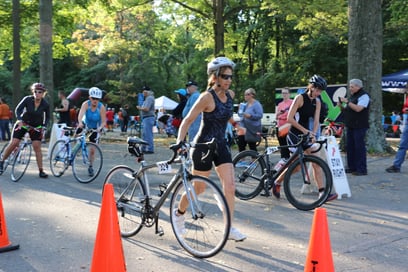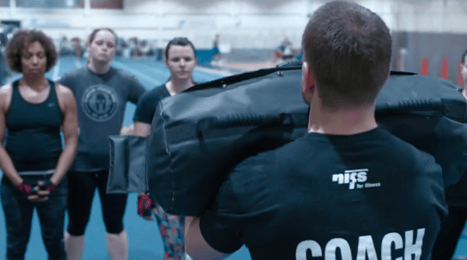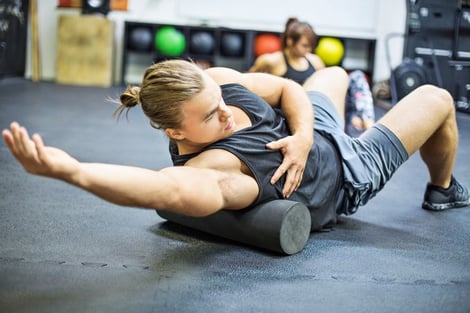 For the majority of my athletic and fitness career, getting sore from activities, workouts, practices, or games has not only been a sign that work has been done, but also a rite of passage. The saying, “no pain, no gain” came about as a result, and the world would judge successful workouts on soreness.
For the majority of my athletic and fitness career, getting sore from activities, workouts, practices, or games has not only been a sign that work has been done, but also a rite of passage. The saying, “no pain, no gain” came about as a result, and the world would judge successful workouts on soreness.
Those days have come and gone, and fitness professionals have come to the understanding that the old saying definitely needs updating. While getting a great workout and being sore is fine, being able to prevent injury, decrease soreness, improve mobility, and increase blood circulation are things we would like to incorporate into our wellness on a daily basis. One thing that I have found in my fitness journey is that you can get a great workout today, and with proper foam rolling (also known as self-myofascial release), you can get back after it tomorrow.
A Brief History of Foam Rolling
Foam rolling might seem like it’s a fairly new concept, but the idea has been around quite a while within manual physical therapy circles and with nontraditional medicine practitioners. In the late 19th century, physicians were using manual therapy to improve blood circulation and lymph flow. Although there are almost no studies that show that foam rolling had any benefits, the people that these techniques were being implemented on seemed to see the benefit.
Fast-forwarding to modern times, we have seen a boom in various industries associated with massage and related therapies. Individuals are seeing great results from meeting with these professionals and become interested not only in the tools they are using, but also in figuring out ways to implement similar techniques and experiences as a way to a quick-fix home remedy. Thus was born the foam roller, which now comes in many sizes, lengths, and shapes, and can be supplemented with everything from heat and ice to vibration discs.
How to Start Foam Rolling
Here are some quick tips and ideas to get you on your way.
- Choosing a density: Pick a foam roller density that matches your comfort level. The softer foam rollers are geared more for beginners who might be sensitive and unable to cope with the discomfort a denser foam roller brings. As you become more accustomed to foam rolling, you may increase the foam roller density to your desired comfort level. As with getting a deep-tissue massage, it might feel uncomfortable at the time, but you may feel great right away, and tomorrow you will feel like a million dollars!
- Rolling before and after bed: NIFS Personal Trainer Kris Simpson, a huge proponent and practitioner of foam rolling, says, “Foam rolling before bed is a great way to relieve muscle tension and stress from a long day. You will sleep better while being better rested, in turn giving you a head start on the following day. Again foam rolling in the morning would help get the blood flowing after a long, unrestful sleep.”
- Finding a pattern: Another NIFS Trainer, Cara Hartman, uses foam rollers with her athletes. She has all of her clients and athletes follow a pattern that makes sense. “We like to start lower posterior (calves) and work our way up (hamstrings, glutes, back, etc). Smaller muscles can be rolled with a little creativity. If you find yourself unable to perform a movement, try putting the foam roller against the wall and rolling vertically as opposed to horizontally.”
- Watch our video on how to properly foam roll.
As you work to get better at foam rolling, understand that it is very similar to everything you do in life. It will be most difficult the very first time you do it, but it will get a little easier each time you try it. I have a personal philosophy regarding foam rolling:
“If you want to maintain current mobility and flexibility, foam roll one time per day. If you want to increase mobility and flexibility, foam roll more than one time per day (the only limit is how much time you have to devote to your wellness). And if you want to get worse, do nothing!”
Foam Rolling at NIFS
NIFS has multiple foam-rolling stations designated to give you as many opportunities to roll as you need. There are multiple lengths and densities as well as a specialty roller made by Rollga. If you would like a quick tutorial and to talk about foam rolling with staff, please stop by the track desk and see one of the Health Fitness Specialists on staff. Get on a roller today, feel great tomorrow!
Evolve and rejoice
This blog was written by Thomas Livengood, devoted NIFS Health Fitness Trainer and Manager and avid blog writer. Missed by his NIFS family and members.


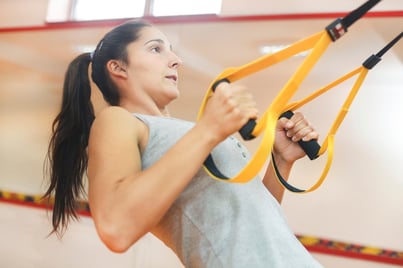 Have you tried TRX class at NIFS? For starters, you may be asking yourself, “What is a trx?” TRX is a body-weight suspension training system designed to give you a total-body workout, while playing to your skill set and allowing for nearly limitless body-weight–oriented exercise. TRX can provide a fitness beginner with an opportunity to learn movement patterns properly as well as challenge the most seasoned veterans in the gym with more advanced progressions.
Have you tried TRX class at NIFS? For starters, you may be asking yourself, “What is a trx?” TRX is a body-weight suspension training system designed to give you a total-body workout, while playing to your skill set and allowing for nearly limitless body-weight–oriented exercise. TRX can provide a fitness beginner with an opportunity to learn movement patterns properly as well as challenge the most seasoned veterans in the gym with more advanced progressions.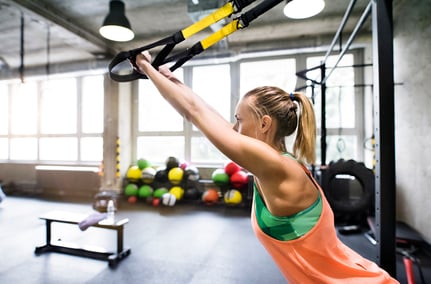 TRX Row: With two handles set to the short length (one tick mark), start with arms long and body in a plank position, being mindful that you do not let your hips sag. While under control, pull yourself up to your hands. Lower back down under control. PRO TIP: You can pull with your hands parallel to the floor to engage the lats more, whereas pulling with your hands horizontal to the floor works the rear deltoids and trapezius. (See video
TRX Row: With two handles set to the short length (one tick mark), start with arms long and body in a plank position, being mindful that you do not let your hips sag. While under control, pull yourself up to your hands. Lower back down under control. PRO TIP: You can pull with your hands parallel to the floor to engage the lats more, whereas pulling with your hands horizontal to the floor works the rear deltoids and trapezius. (See video 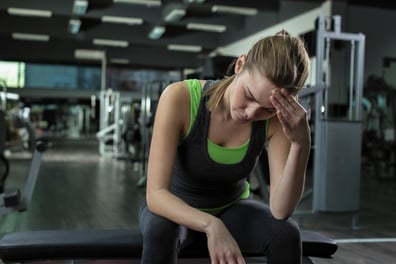 Have you ever woken up feeling like a truck ran you over? This might be due to an underlying illness; whether it be a cold, flu, bronchitis, or some other bug, it seems to happen to everyone at least once per year. When it comes to fitness, we sometimes have to make a choice: “Should I work out or should I rest?” The answer to this is not as cut and dried as it might seem. We’ll look at when it’s a good idea to stay home and chill and when you can just “sweat it out.”
Have you ever woken up feeling like a truck ran you over? This might be due to an underlying illness; whether it be a cold, flu, bronchitis, or some other bug, it seems to happen to everyone at least once per year. When it comes to fitness, we sometimes have to make a choice: “Should I work out or should I rest?” The answer to this is not as cut and dried as it might seem. We’ll look at when it’s a good idea to stay home and chill and when you can just “sweat it out.” Throughout your life, you will come across times and situations that are tough, making you feel as though getting through it all is inconceivable and hopeless. There are more traditional ways to deal with these ups and downs of life, such as therapy, but there are other ways to overcome stress in life that can be as easy as taking a walk, shooting some basketball, or even lifting weights.
Throughout your life, you will come across times and situations that are tough, making you feel as though getting through it all is inconceivable and hopeless. There are more traditional ways to deal with these ups and downs of life, such as therapy, but there are other ways to overcome stress in life that can be as easy as taking a walk, shooting some basketball, or even lifting weights. We exercise many ways every day, many times unknowingly. Sometimes this is because we actually enjoy doing it and it doesn’t seem like work to us. As the old saying goes, “time flies when you’re having fun.” One requirement for a lifetime activity, though, is that it most often needs to be something you can do from the time you stop wearing diapers until the time you start wearing diapers again. The ideas I like to explore can include fitness, but also non-exercise–based activities.
We exercise many ways every day, many times unknowingly. Sometimes this is because we actually enjoy doing it and it doesn’t seem like work to us. As the old saying goes, “time flies when you’re having fun.” One requirement for a lifetime activity, though, is that it most often needs to be something you can do from the time you stop wearing diapers until the time you start wearing diapers again. The ideas I like to explore can include fitness, but also non-exercise–based activities.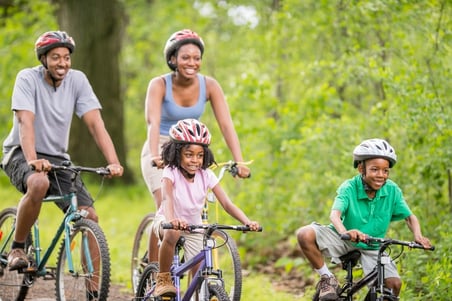 Running, skipping, hopping, bounding, throwing, and crawling are all activities children around the world enjoy and are necessities for proper movement development. Most sports and lifetime fitness activities require one or more of these basic motor skills. Developing basic motor skills sometimes is not our main priority when it comes to our children’s upbringing. In our lifetime, the focus on physical education has somewhat declined due to various reasons, with one reason being a deemphasis on playground time and even family-time physical activity. Beyond physical fitness, there are many other benefits that one can get from being more active, especially at a young age.
Running, skipping, hopping, bounding, throwing, and crawling are all activities children around the world enjoy and are necessities for proper movement development. Most sports and lifetime fitness activities require one or more of these basic motor skills. Developing basic motor skills sometimes is not our main priority when it comes to our children’s upbringing. In our lifetime, the focus on physical education has somewhat declined due to various reasons, with one reason being a deemphasis on playground time and even family-time physical activity. Beyond physical fitness, there are many other benefits that one can get from being more active, especially at a young age. It’s staggering how many people in the world are affected directly and indirectly by health problems. You might not have an incurable disease, but there is a chance that someone you love does. Sometimes there are medications and treatments for these conditions, but not everyone receives the attention they need. Sometimes there are no medications. Fortunately, people have organized charitable foundations that help find cures, medicines, and other aid for those in need.
It’s staggering how many people in the world are affected directly and indirectly by health problems. You might not have an incurable disease, but there is a chance that someone you love does. Sometimes there are medications and treatments for these conditions, but not everyone receives the attention they need. Sometimes there are no medications. Fortunately, people have organized charitable foundations that help find cures, medicines, and other aid for those in need.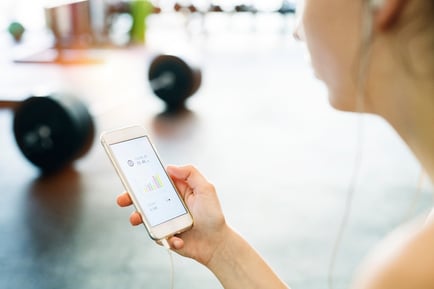 Technology can be incredibly
Technology can be incredibly  Following on from
Following on from 